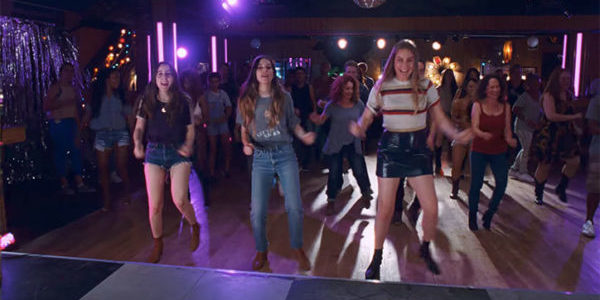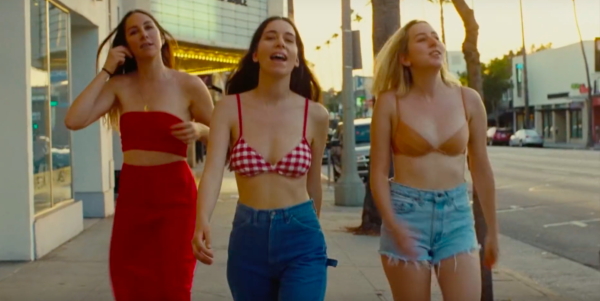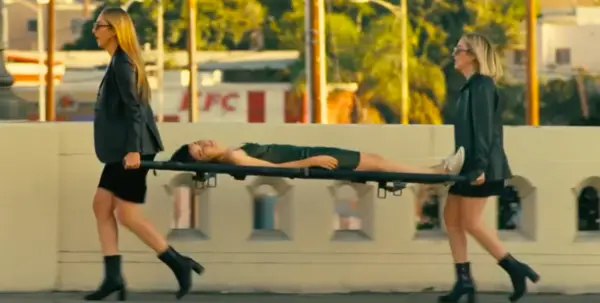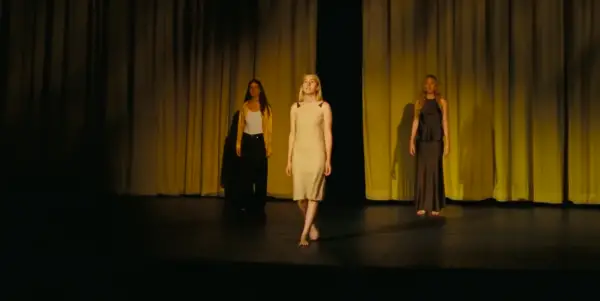Paul Thomas Anderson & HAIM: Elevating The Music Video Medium
Aspiring journalist and film critic based in the SF Bay…
In April 2017, indie trio HAIM released a live recording of their new, unreleased song “Right Now” in a video directed by Paul Thomas Anderson. Shot on 35 mm film and in one unbroken take, the video opens on lead singer Danielle Haim seated at a piano, then slowly pans to Este Haim and Alana Haim as Danielle begins singing. Her voice drifts in tandem with the camera, crooning “now you’re saying that you need me babe” as bassist Este echoes with “right now, right now” and Alana punctuates the statements with reverberating guitar. It’s a raw, powerful song that is complemented by Anderson’s intimate direction – the grainy softness of the film and grace of the cinematography granting a heightened sense of tangibility to the women and their encasing studio.
Later released as part of the short film “Valentine” (featuring three live studio performances shot by Anderson), the video was the very first collaboration between the musical group and the director. What has followed are four incredible music videos that capture the band’s energy with ease, and make full use of the medium’s capabilities in a stunning display – a reinvigoration of the art of the music video.
“Little Of Your Love”
The exuberance of “Little Of Your Love” is so palpable it beckons listeners to dance on the spot, and the music video (released October 2017) is just that – a solid three and a half minutes of nothing but dancing in famed L.A. bar Oil Can Harry’s. The song itself is driven by a “50s rock vibe” (as described by Danielle) with hearty guitar and piano mingling harmoniously, and exudes a retro vibe that is reflected in its music video. The sisters line dance with the bar’s patrons under a twinkling disco ball, simple choreographed dance moves executed with a slight imprecision that gives a sense of natural spontaneity — the synchronized glee of a movie-musical number without the stiff falseness.

The setting never shifts from the center dance floor but the constant motion of the camera, the people, and the lights prevent a sense of stagnance. Colors dapple smiling faces and shift from warm yellow and orange to cool blue and purple. Supporting it all is the core chant of “give me just a little of your love” that comprises most of the lyrics, a coaxing bid to a hesitant lover. It’s an uncomplicated, joyous song accompanied by an alike video that easily transmits its jubilation to its audience.
“Summer Girl”
The “Summer Girl” video (released July 2019) is significantly more cryptic. The sisters begin walking through L.A. somberly, shrouded in heavy coats, but slowly peel off articles throughout the duration of the song until they’re skipping along the sidewalk in bralettes and shorts. All the while, a man playing a saxophone follows them. The concept is strangely fitting in its execution, accompanying a track that was written in response to Danielle’s partner and longtime producer Ariel Rechtshaid being diagnosed with cancer.

“I wanted to be this light that shined on him when he was feeling very dark,” Danielle said of the track on Twitter. In that sense, the curly haired sax player serves as a personification of Danielle’s emotions toward her partner, both worry and love. He’s ever-present as the three women saunter around through day and night, and is constantly in Danielle’s eye. She even confronts him at a stop at the New Beverly Theater, looking at him from behind the ticket booth and demanding “walk beside me, not behind me”.
In its essence, however, the track is a sunny ode to unconditional love, with the chorus of “I’m your summer girl” accompanied by a gentle, Lou Reed-esque vocal riff of “doo-doo doo-doo-doo-doo…”. The sisters’ moods seem to rise with each article of clothing they toss aside, bathed in sunlight and street lights as they ceaselessly walk. At the end of the video, the sax player finally abandons the group and walks in the other direction. Danielle looks behind at him briefly before turning away to join her sisters – reassured with knowledge of his presence, without letting it weigh her down – and they run past the camera with wide smiles.
“Now I’m In It”
“Now I’m In It” (released October 2019) is the most chaotic track of the P.T.A./HAIM quartet, and the music video reflects it as such. We follow Danielle throughout L.A. as she exits a low-lit bar, slogs through a diner shift, visits a thrift store, then collapses and is taken to a car wash by her sisters to be scrubbed clean – all the while the music thrums in the background. “Now i’m in it is about going through it. a depression. not leaving the house type shit. [sic]” Danielle explained on Twitter.

It’s a turbulent song with lyrics recited so fast they border on spoken word, a panicked inner monologue as mind battles with body.“I, I can’t get a hold of myself” breathily uttered. Each instrumental beat is subtly hit in the music video – a hand grasping a bar counter, a head turn examining an open road, a tilt of sunglasses. It’s a dance in and of itself as the women move in sync with the rhythm.
The distress and eventual recovery from depression is personified within the video as Danielle is hauled away on a stretcher by her sisters and hurried into a car wash, drenched then dried and gently clothed by her sisters in a fog of steam — a rough awakening with a fall in the arms of loved ones. They then strut out into the night, back to the same bar Danielle stumbled out of in the beginning of the music video, but with newfound strength. Danielle gives a stray glance to the camera as she walks with her sisters, lips slightly turned up in the beginnings of a smile.
“Hallelujah”
The latest collaboration between Anderson and HAIM is the deeply intimate “Hallelujah”, released November 2019. The song is a vulnerable rumination on love and loss, with each Haim sister writing and singing their own verse over a stripped-down instrumental composed solely of acoustic guitar and choral harmonies.
The production of the music video echoes this simplicity, taking place on an empty, unadorned stage. The women tread barefoot as they move across the stage, the camera shifting its focus in accordance to their respective verses. Magical realism permeates throughout the video as they move chairs and curtains and switch off lights telekinetically. Danielle and Este sit back-to-back suspended in the air at one point. It’s an enchantment that binds the three sisters as they move to support each other – Danielle tugging Este’s chair with an invisible rope, and the elder two sisters closing the curtains after Alana walks through. The bonds of sisterhood made visible.

Danielle and Este’s verses are a pure ode to these bonds, but Alana’s verse is more specific, focusing on the passing of her best friend Sammi Kane Kraft. “Losing her put a lot of things in to [sic] perspective for me. I was so lucky to have my sisters at this time in my life” she shared on Instagram. The latter third of the music video puts her at the forefront as she steps into the spotlight on stage, elder sisters flanking her in the background, and cries out “everywhere, you’ve been with me all along”. The video concludes with Danielle walking out of the theater, past Este in the box office, and Alana perched atop a ladder arranging the “HALLELUJAH” spelled out on the theater marquee. She walks past the camera before its final seconds, so in the very last frame, Alana is the only one visible. Her silhouette eases down the ladder in the distance as “HALLELUJAH” glows above her.
Furthering the Art of Music Videos
What makes all four music videos equally striking is the lack of harsh gimmickry that is so often employed within the medium, and the distinct perspective they all share. Anderson allows the women’s movements to speak for them without adding extraneous special effects, capturing them in sweeping camera movements and extensive tracking shots. Focus is kept on their faces and bodies in each video so they’re kept centered in the frame and directly serenade the camera. The themes of each song are smoothly translated into video as well, whether directly personified or conveyed through general tone, and provide depth without feeling alienating and frustratingly elusive. Audiences are stimulated visually and mentally .
But perhaps the most important feature is the usage of film – with Anderson shooting all videos on 35 mm film rather than digital. It lends a cinematic feel to all four features, and provides a refreshing sense of importance within an age where music videos are largely dismissed as cheap fodder – showing a level of care the medium does not always receive. It’s not even the specific difference between film and digital that is most important (though the former is considered to be superior to the latter, it’s markedly less accessible) but the choice that Anderson makes. He has the resources at his disposal and makes a point of using them with purpose without overstuffing the video itself. Within a budget that many directors would wear thin on set design, props, and special effects, Anderson invests with a keen awareness of what aspects of film production have the most impact on the feature, and ultimately, its audience.
It’s this care that even prompted Anderson and HAIM to premiere the “Summer Girl” music video at the New Beverly Theater, and screen the video in 35 mm film before various theater showings for a whole week. It’s a cinematic treatment that’s strange only in its rarity, and perhaps will set a precedent in the art form. Because that’s exactly what music videos are — an art. Though the definition has begun to slip away, it’s creatives like HAIM and Anderson who stoke its fire, and will hopefully continue to do so well into the future.
Does content like this matter to you?
Become a Member and support film journalism. Unlock access to all of Film Inquiry`s great articles. Join a community of like-minded readers who are passionate about cinema - get access to our private members Network, give back to independent filmmakers, and more.
Aspiring journalist and film critic based in the SF Bay Area. Loves Guillermo Del Toro, Bong Joon-Ho, and any film with an impromptu dance number.













